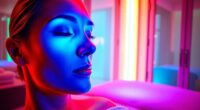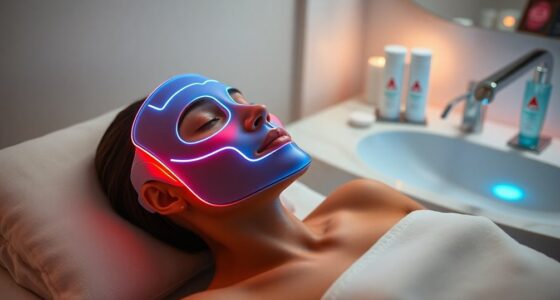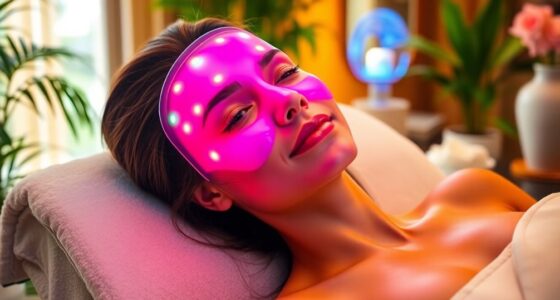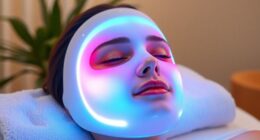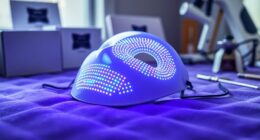To spot a high-quality LED mask, look for clinically proven wavelengths like red, blue, and near-infrared that target specific skin issues. Ensure it has a high LED count—ideally around 1600—for effective coverage. Check for safety certifications like CE, RoHS, and FDA approval to guarantee your mask meets health standards. Multi-treatment modes can address various concerns, and durable materials such as polycarbonate and silicone enhance comfort. Finally, consider customer reviews and brand reputation for reliability. There's more to discover about essential features that can elevate your skincare routine and help you make the best choice!
Key Takeaways
- Look for masks with a high LED count (ideally over 100) for better coverage and treatment effectiveness.
- Ensure the mask features clinically proven wavelengths, such as red and near-infrared, targeting specific skin concerns.
- Check for safety certifications like CE, RoHS, UL, and FDA clearance to guarantee product safety and effectiveness.
- Opt for masks made from durable, hypoallergenic materials like polycarbonate or medical-grade silicone for comfort and light transmission.
- Select masks with multiple treatment modes to address various skin issues and enhance overall treatment convenience.
Wavelengths and Efficacy
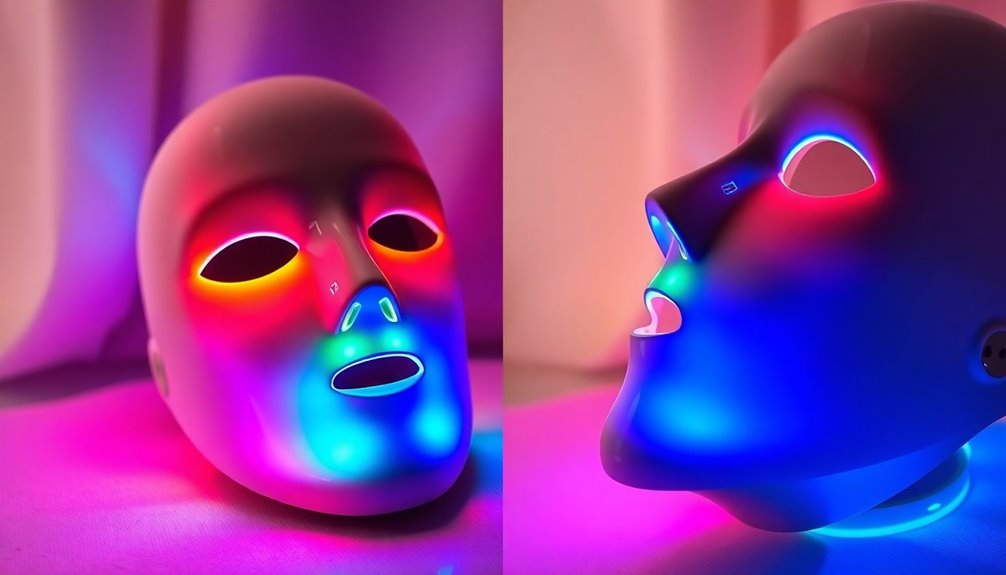
When it comes to LED masks, understanding wavelengths and their efficacy is key to achieving your skincare goals.
Focus on clinically proven wavelengths like red light (633nm) for reducing inflammation and pigmentation, and near-infrared light (830nm and 1072nm) for boosting collagen production in deeper skin layers. Combination therapy that utilizes both red and near-infrared light can maximize benefits for mature skin.
If you struggle with acne, blue light (415nm) is effective at neutralizing acne-causing bacteria.
Avoid unproven wavelengths like yellow or green, as they lack solid clinical support.
For the best results, look for masks that combine these wavelengths, enhancing treatment efficacy for various skin issues.
Number of LEDs and Coverage
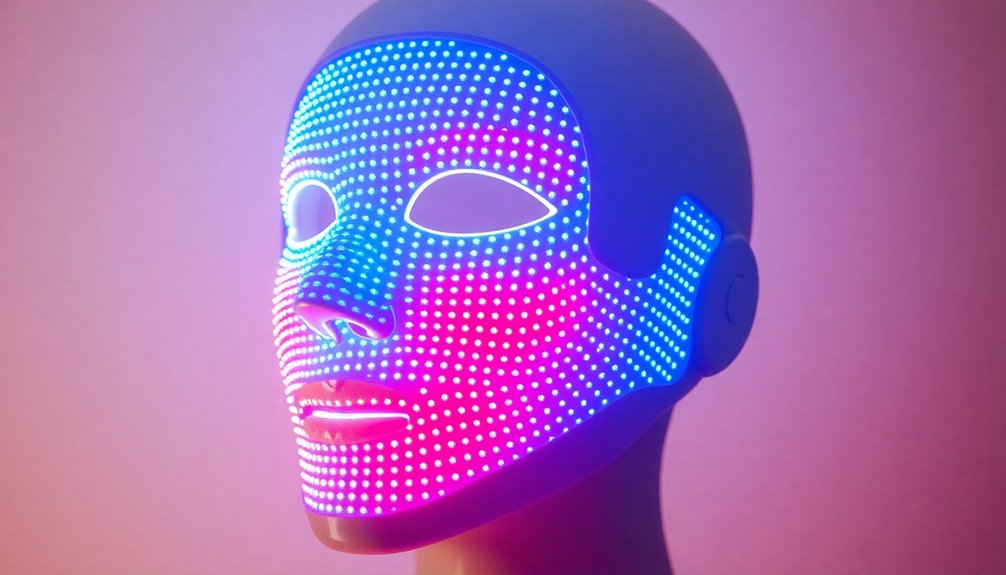
The number of LEDs in an LED mask plays a crucial role in determining its effectiveness and coverage. Masks with more LEDs provide better overall coverage, allowing for a more thorough skin treatment. High-quality masks often feature densely packed professional-grade LEDs, significantly increasing the total energy delivered, which can enhance your results. When comparing masks, look for those with higher LED counts—like the LumaLux Face+ with up to 1600 LEDs—versus those with only 66 to 100 LEDs, as the latter may deliver less effective treatments. Additionally, ensure the LEDs are evenly distributed to maximize coverage. Remember, a mask with optimal irradiance levels will also improve treatment efficiency, helping you achieve your skincare goals faster. Regular use of these masks can significantly improve skin texture and tone, enhancing the benefits of LED light therapy.
Safety Standards and Certifications

A high-quality LED mask not only needs to have an adequate number of LEDs for effective treatment but also must adhere to safety standards and certifications.
Look for CE marking, which ensures compliance with safety, health, and environmental standards in the European Economic Area. RoHS compliance is crucial too; it restricts hazardous substances, protecting both your health and the environment.
UL certification indicates rigorous testing for electrical safety and performance, providing assurance of quality. If the mask is marketed as a medical device, check for FDA clearance, which confirms safety and effectiveness for its intended use. Additionally, ensure the product complies with ISO 13485 certification, which indicates adherence to quality management standards.
Together, these certifications ensure you're choosing a safe and reliable product for your skincare routine.
Treatment Modes and Colors
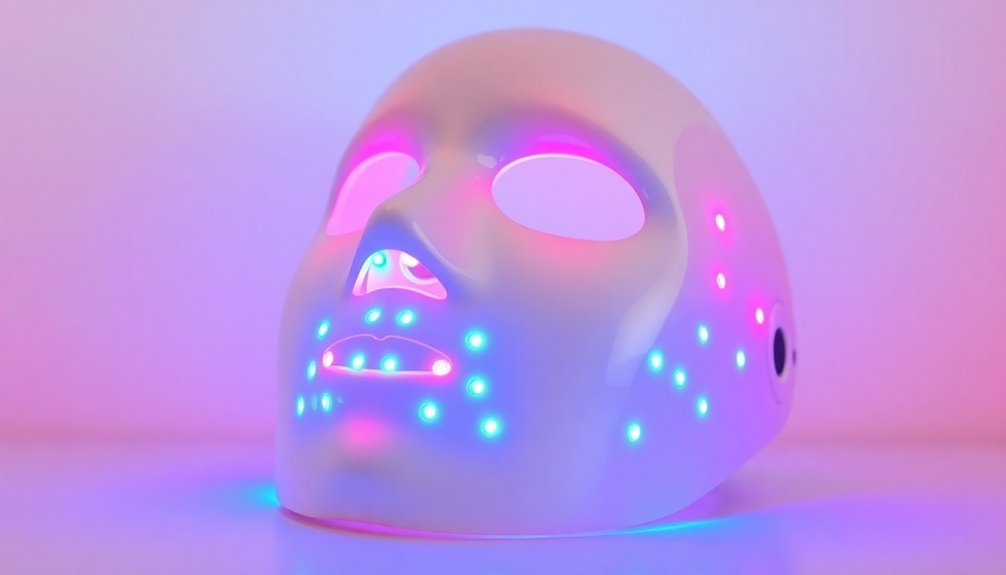
Understanding treatment modes and colors in LED masks is essential for achieving your skincare goals. Different wavelengths target specific skin concerns.
For instance, red light (633nm) boosts collagen production, while blue light (405-420nm) fights acne-causing bacteria. Green light (495-570nm) balances skin tone and reduces hyperpigmentation, and near-infrared light (460-850nm) improves acne-prone skin and controls oil. Regular use of LED masks can lead to enhanced skin elasticity, making them a valuable addition to your skincare routine.
When choosing a mask, consider the number of treatment modes. Basic masks offer single-color treatment, while comprehensive options feature multiple modes and customizable settings.
Automatic modes treat your skin with all settings in one session. Ensuring the wavelengths are clinically proven is crucial, as this guarantees effective treatment.
Select a mask that clearly states its specific wavelengths for optimal results.
Durability and Material
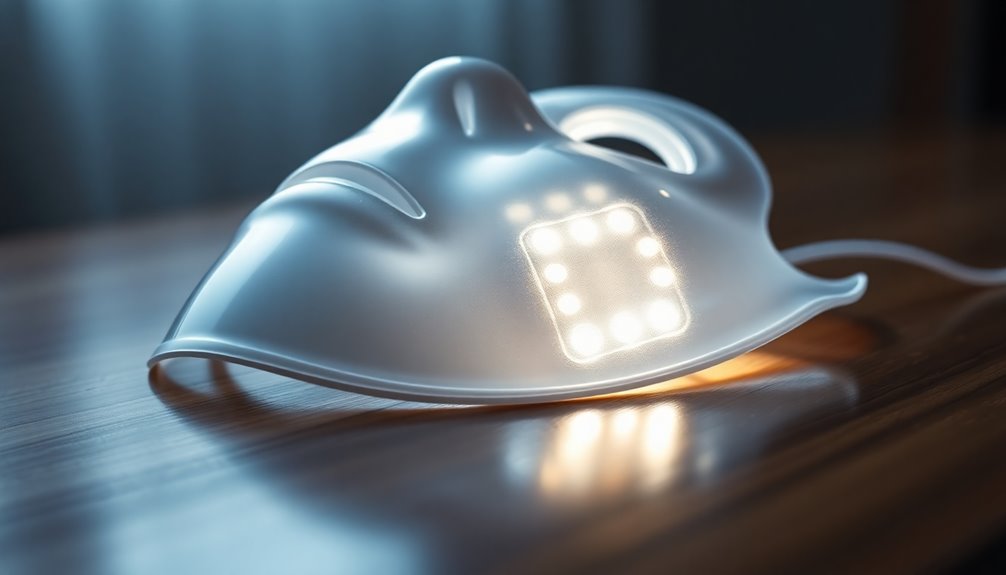
When selecting an LED mask, the durability and material play a crucial role in ensuring effective treatment and user comfort. Opt for masks made from polycarbonate, which offers up to 89% light transmission and excellent impact resistance. Unlike plastic, which transmits only 80% light and is flammable, polycarbonate ensures better treatment outcomes. Additionally, consider masks that incorporate LED technology for enhanced visual effects and functionality.
If comfort is your priority, look for hypoallergenic materials like medical-grade silicone or thermal smart fabrics that provide a customized fit. These materials not only enhance light therapy effectiveness but also minimize skin irritation. Always check for safety certifications, ensuring the mask meets strict guidelines and uses low-voltage DC power for added safety. Prioritize materials that support clinical wavelengths for optimal results.
Additional Features and Convenience
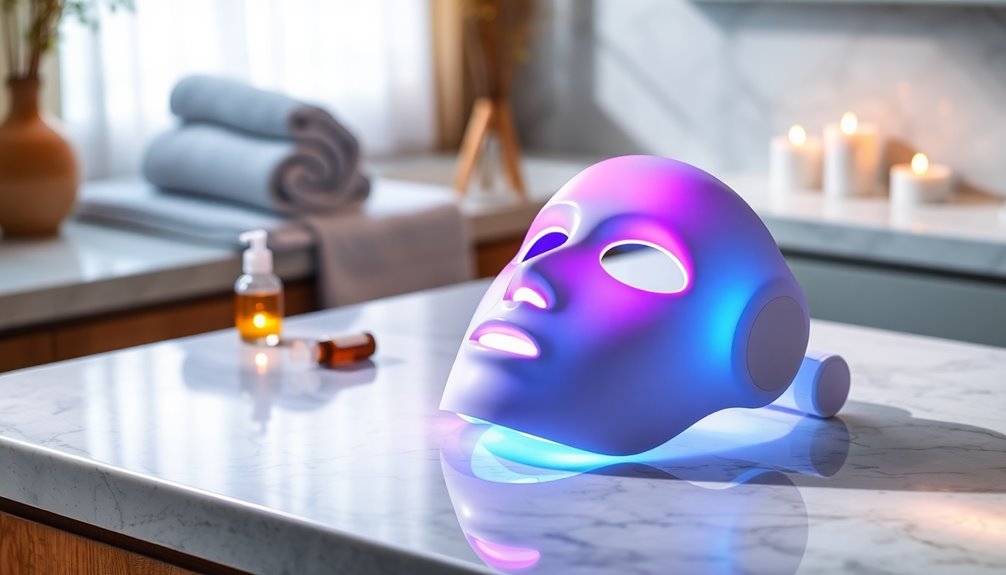
While exploring LED masks, you'll find that additional features and convenience can significantly enhance your experience.
Look for adjustable straps that accommodate different head sizes and a wire-free design that uses a rechargeable magnetic power supply. These elements make it easy to move around while using the mask.
A lightweight and ergonomic design ensures comfort, reducing discomfort during longer sessions. The SkinAct LED Light Therapy Mask is designed for both home and studio use, making it versatile for various environments.
Multiple treatment modes allow you to customize your skincare routine to address specific concerns, and an intuitive user interface often means you can operate it with just a single button.
Finally, the stretchable silicone material and face-shaped design help the mask conform to your facial contours, providing better coverage and a snug fit.
Brand Reputation and Customer Reviews
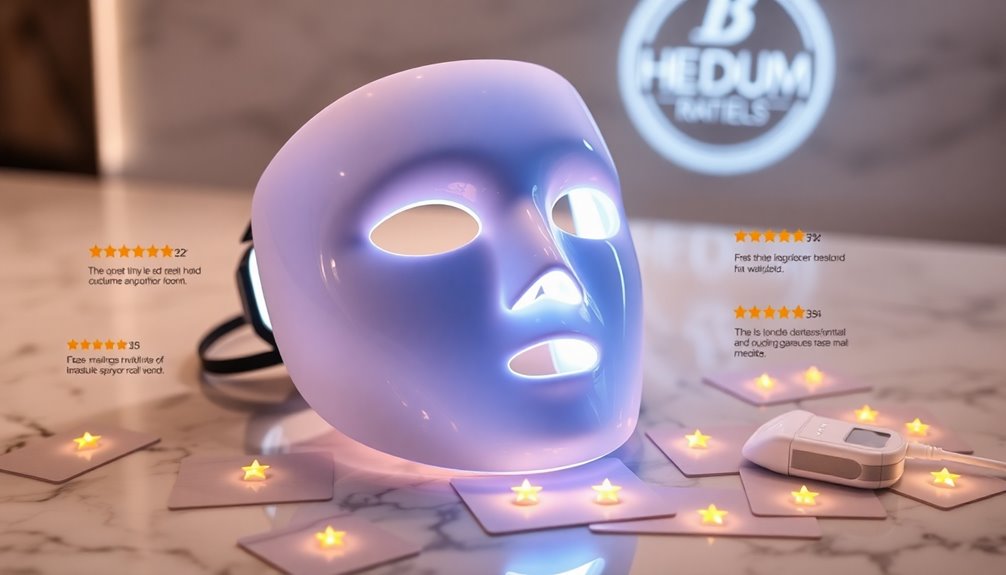
How can you ensure you're choosing a high-quality LED mask? Start by checking the brand's reputation. Look for reputable manufacturers with FDA approval, CE marking, or ISO certification. Endorsements from dermatologists and clinical data supporting their LED wavelengths also signal quality. Additionally, consider the number of LED lights offered by the mask, as more LEDs typically correlate with enhanced treatment efficacy.
Next, dive into customer reviews. Read a variety of feedback to get a balanced perspective. Positive reviews with high ratings are encouraging, especially if they mention specific skin concerns like acne or aging. Long-term results can indicate the mask's effectiveness over time.
Lastly, compare the brand with others to gauge its standing in terms of quality and efficacy. By focusing on these elements, you'll make a more informed decision.
Frequently Asked Questions
How Often Should I Use an LED Mask for Best Results?
You should use your LED mask 2-3 times a week for the best results.
This frequency allows your skin to absorb the benefits without overdoing it.
If you're dealing with acne, start with three sessions weekly, then reduce to one or two as your skin clears.
For anti-aging benefits, consistency is key—stick to this schedule to boost collagen and improve skin elasticity over time.
Always adjust based on your skin's response.
Can I Use Makeup Before or After Using the LED Mask?
You shouldn't use makeup before or after using your LED mask if you want the best results.
Makeup acts as a barrier, reducing the light's effectiveness and absorption into your skin. For optimal benefits, cleanse your skin first, then use the mask.
If you need to wear makeup afterward, wait until the treatment session's over.
Are There Any Side Effects Associated With LED Mask Usage?
Oh sure, who wouldn't want to risk their eyesight for a glowing complexion?
While LED masks can be enticing, they come with side effects like mild irritation, prolonged exposure risks, and potential eye issues if you don’t take precautions. It’s essential to follow the manufacturer’s guidelines to minimize these risks and ensure a safe experience. Additionally, users should be aware of led mask safety concerns such as wearing the mask for extended periods without breaks, which may exacerbate skin sensitivity. With proper use and attention to these precautions, you can enjoy the benefits of LED masks while minimizing any negative effects.
If you've got sensitive skin or certain health conditions, you might want to consult a dermatologist first.
Always remember to follow the manufacturer's guidelines and maybe invest in some blackout goggles—because why not?
Is the LED Mask Suitable for All Skin Types?
Yes, LED masks are generally suitable for all skin types, including sensitive skin.
Their non-invasive nature allows you to use them without worrying about irritation. You can customize the light settings to address specific concerns, whether you're dealing with acne, aging, or pigmentation.
However, it's a good idea to consult a dermatologist to ensure the specific mask you choose meets your skin's unique needs and conditions for the best results.
How Long Should Each Treatment Session Last?
Imagine sinking into a cozy chair, a warm glow enveloping your face as you enjoy your LED mask session.
For optimal results, aim for 10 to 20 minutes per treatment. Most skin conditions respond well to 10 to 15 minutes.
Stick to using your mask two to five times a week, and remember, consistency is key.
Follow the manufacturer's instructions to ensure you get the best out of your glowing experience!
Conclusion
When you're on the hunt for a high-quality LED mask, remember that not all masks are created equal. Did you know that studies show LED therapy can improve skin texture by up to 80% after consistent use? By considering factors like wavelengths, safety certifications, and brand reputation, you can make an informed choice. Investing in the right mask could be the key to achieving that glowing complexion you've been dreaming about. Happy shopping!

